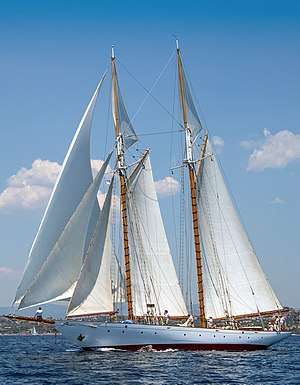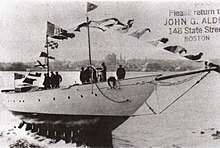Puritan (schooner)
The Puritan is a 126-foot gaff rigged schooner designed by naval architect John Alden and built-in 1930. Originally commissioned by Edward W. Brown in 1929, it was later used as a patrol schooner by the United States Navy during World War II. The Puritan has been used mainly as a charter vessel and undergone numerous restorations. It is currently operated by The Classic Yacht Experience and used as a charter in the Mediterranean Sea.
 Puritan sailing in the Spetses Classic Regatta in 2017. | |
| History | |
|---|---|
| Name: | Puritan |
| Operator: | The Classic Yacht Experience |
| Builder: | Electric Boat Company (Designed by naval architect John Alden) |
| Launched: | 1931 |
| General characteristics | |
| Type: | Gaff rig Schooner |
| Length: | 126 ft (38 m) |
| Beam: | 23 ft (7.0 m) |
| Draft: | 9 ft (2.7 m) |
| Sail plan: | Gaff–rigged |
| Speed: | 9.5 kts |
| Capacity: | 8 |
| Crew: | 7 |
History

The Puritan was built by the Electric Boat Company in 1930. The plans for the schooner were originally presented to Edward W. Brown by John Alden in 1929.[1] The ship was completed in 1931 and was the only pleasure boat build by the Electric Boat Company during that period due to the beginning of the Great Depression.[2] The ship was christened in 1931 and made its maiden voyage from New London, Connecticut to Oyster Bay.[3]
The Puritan was put up for sale in 1932 after the death of Edward Brown. It was purchased in 1933 by Harry Bauer, the president of Southern California Edison, for $35,000.[4] He sailed the ship from the eastern United States to California by way of the Panama Canal. Sterling Hayden, only seventeen at the time, was a passenger on the journey and would later write about it in his 1963 biography, Wanderer.[5] Bauer sold the Puritan for $1 to the United States Navy on December 7th, 1941, the day of the Attack on Pearl Harbor.[2][3]
Beginning active duty with the U.S. Navy, commissioned as USS Puritan (IX-69), Puritan was assigned to the Western Sea Frontier, 11th Naval District, San Diego. Fear of Japanese attack had reached a zenith on the west coast by 1942. Puritan operated on the San Diego Coastal Patrol throughout her Naval career, guarding against such an attack. Puritan had but a brief tour with the U.S. Navy and was placed out of service at San Diego, California, on 27 September 1943. She was struck from the Navy Register on 28 June 1944 and transferred to the War Shipping Administration for return to her former owner on 18 November 1944.
Bauer owned the Puritan up until his death in 1961. In 1957, he allowed the American Museum of Natural History in New York to use the Puritan as a base of operations for an expedition.[6] The expedition focused on the gulf of California and logged more than 4,000 miles while collecting specimens and studying the region.[3] Members of the expedition included Oakes Plimpton, Richard Van Gelder, and Richard G. Zweifel and led to the discovery of Van Gelder's bat, among other finds. [7] In 1963, the boat was purchased at auction for $90,300 by Doyle D.W. Downey after sitting in mooring for two years after Bauer's death.[8]
Downey had previously purchased the Satartia (later known as Southwind) from Bauer, another schooner designed by John Alden.[8] Downey used the Puritan in the charter trade in the Virgin Islands.[3] In 1967, he ended up selling the Puritan to Mariano Prado-Sosa for $120,000. Mariano was a member of a wealthy Peruvian family that included Mariano Ignacio Prado, former president of Peru. Mariano refurbished the schooner and begins using it as a charter between Miami, Florida and the Virgin Islands.[2] The boat was seized by the Mexican government on a charter to Acapulco. It was seized on behalf of the Peruvian government who blamed the Prado family for inequalities in Peru.[3]
.jpg)
In 1971, the Puritan was towed from Acapulco to Costa Rica and then brought back to Miami. At the time, the schooner was in poor shape in that nothing on the boat was operative except for the main engine. The toilets were plugged, batteries dead, and it could not travel more than four knots due to the condition of the hull.[3] It was purchased by Bill and Patsy Bolling in 1972, who spent seven months restoring the schooner. They returned the Puritan to charter in the Caribbean and also took part in schooner races, winning the Mystic Seaport Invitational Schooner Race in 1973.[9]
The Puritan was sold to Oscar Schmidt in 1978.[10] Schmidt sailed the Puritan to Newport, Rhode Island in 1980 for the America's Cup races.[1] While there, he entered it into the Classic Yacht Regatta where it won first in class.[1] The schooner spends the next decade sailing the world, visiting places such as Bermuda and France. In 1989, it was sold again, this time to Arturo Ferruzzi who keeps it in Antibes until it is sold to the current owner in 2015. It underwent a full refit and was put into service as a charter vessel with The Classic Yacht Experience.[11]
References
This article incorporates text from the public domain Dictionary of American Naval Fighting Ships. The entry can be found here.
- Carrick, Robert W.; Henderson, Richard (1995). John G. Alden and His Yacht Designs. Mc Graw-Hill. ISBN 9780070282544.
- Serafini, Flavio (2002). Vele allo specchio (Interni, particolari e restauri di scafi d’epoca). ISBN 9788879061865.
- Oristano, Victor (December 1973). "A Queen Is Reborn" (in Italian). Motor Boating.
- "Shipping News". Los Angeles Times. 20 June 1933.
- Hayden, Sterling (1998). Wanderer. Sheridan House. ISBN 9781574090482.
- "Expedition to Hunt for Coast Animal Specimens". Los Angeles Times. 3 March 1957.
- Template:Plimpton, Oakes A., ''1957 Expeditions Journal: Baja California American Museum of Natural History Expedition Journal Spring 1957 Huautla Mexico Seeking The Sacred Mushroom With Gordon Wasson Summer 1957'' (2016)
- Ames, Walter (17 June 1963). "Owner of Two Yachts Buys 3rd in Southland". Los Angeles Times.
- Devlin, John C. (23 September 1973). "Schooners Rule for a Day at Mystic". The New York Times.
- "Puritan, 1931" (in Italian). Nautica Report.
- Pozzo, Fabio (2 July 2017). "L'ingegnere aerospaziale che riporta in vita le principesse del mare" (in Italian). La Saampa Mare.